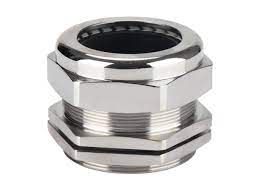Cable connectors/fittings called Stainless Steel Cable Glands are used to snugly fasten cables to other electrical equipment like electrical terminals, plugs, and explosion-proof junction boxes. Their advantage is that they can shield delicate electrical wire from moisture, corrosive vapors, rust, and corrosion. Materials including brass, brass that has been nickel-plated, and SS316 can be used to make the glands.
The cable is introduced into the housing in a sealed and strain-relieved manner via a stainless steel cable gland, also known as a compression fitting or cable entry. Enclosures might be plugs, terminal boxes, control cabinets, control panels, boom boxes, crane blocks, or wiring boxes. When the cable passes through a side wall or sheet metal plate and into the terminal compartment, a cable gland makes sure the cable is well sealed. Furthermore, it guarantees that the control cabinet is shielded from outside effects (e.g. dust or moisture). Additional characteristics, such as EMC compatibility or ATEX permits for EX-protected areas, must be considered depending on the application area and environmental impacts.
Thanks to unique anti-kink sleeves, stainless steel cable glands do more than only seal or relieve the lines; they also stop the cable from kinking. Therefore, a cable gland both safeguards the electrical equipment itself and guarantees that cables attached to a control cabinet continue to operate as intended.
Stainless steel cable glands are typically utilised in outdoor and hazardous locations and must be compatible with the environment in which they are being used. The more robust the cable gland needs to be, the harder the environment or/and more crucial the cable is, as it can be expensive if something goes wrong by utilizing the incorrect cable gland in the incorrect environment.
cable glands with ATEX certification
Specially designed ATEX cable glands are used in corrosive and hazardous settings. They could shield electrical wiring from dangerous gas, water, dust, and other elements. Both armored and non-armored ATEX cable glands are available. There is further information concerning the "Ex e" and "Ex d" criteria, which some of these glands also adhere to, here. If you're installing cable glands in corrosive or hazardous settings, ATEX certified ones are required.





Comments